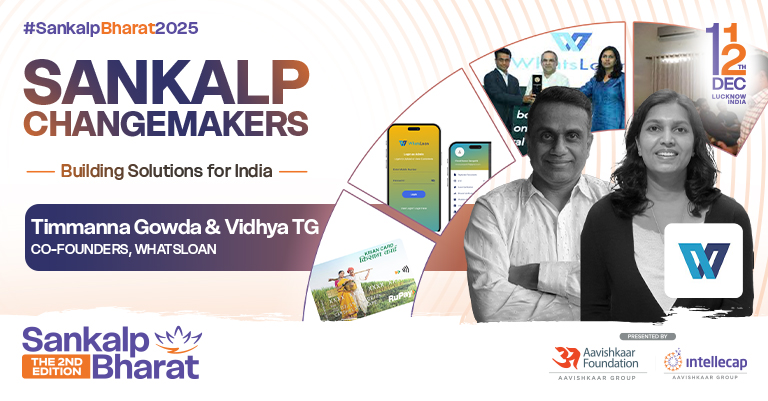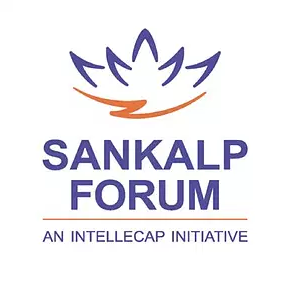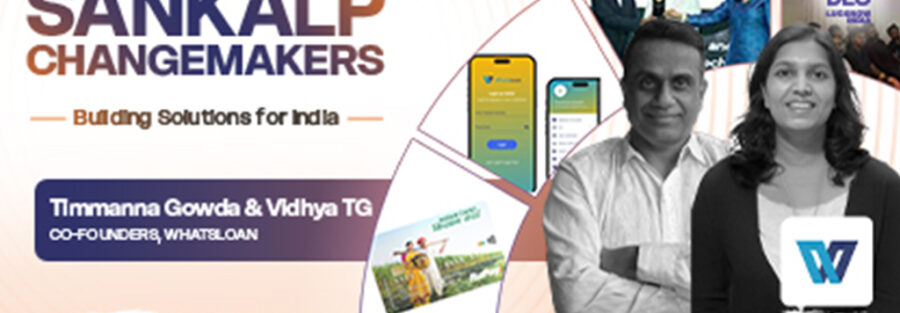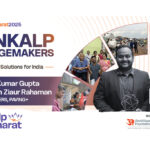

A farmer needs a loan to buy seeds for the upcoming season. Simple enough!! But here’s what actually happens, multiple trips to the bank branch, stacks of paperwork, weeks of waiting, and costs that eat up 5-10% of the loan amount itself.
Let’s remember, for a farmer the cost is only one expense. A day not working in the field is also an expense translating into loss of revenue, and the problems and complexities are endless.
This wasn’t just inefficient. It was broken.
To make a cut for Sankalp Changemakers, there’s one important element that needs to be undertaken – impact at the centre with an easy, scalable solution for an evident problem. And Timmanna Gowda picked this problem which was lying in plain sight for many. With 25+ years in banking at institutions like Axis Bank, he understood the system inside out, but more importantly, he understood what it was doing to farmers.
Loans are a part of agricultural life. They’re not optional – they’re survival. It means smoothening out a very important part of farming, bringing farmers closer to focus on the actual needs of agriculture rather than drowning in red tape.
In August 2019, Timmanna Gowda, along with co-founder Vidhya TG, who brought 15+ years with HDFC Bank and Citi Group, decided to do something about it. They founded WhatsLoan with a simple but radical idea: What if getting a farm loan was as easy as sending a WhatsApp message?
What it does: WhatsLoan is a digital lending platform that eliminates the traditional barriers between farmers and credit. It’s a completely paperless, presenceless, underwriterless, and branchless system that transforms the entire loan journey – from application to approval to disbursement – into a simple digital process that takes minutes instead of weeks. Built on RBI’s Unified Lending Interface (ULI), the platform works with PSU banks like Union Bank and Karnataka Grameena Bank to bring institutional credit directly to farmers’ fingertips, in their own language, on their mobile phones, without ever having to step into a bank branch.
Staging Days to Scaling Days
The early days weren’t easy. The banking systems had been built for banks, not for borrowers. They were designed for branches, not for villages. The operational cost alone, 3-5% on low-ticket loans, made serving rural customers almost unviable for traditional banks.
But Timmanna and Vidhya had a vision – build a completely digital platform that was paperless, presenceless, underwriterless, and branchless. It sounded impossible. Banks had trie ‘digital’ before, but it usually meant scanning paper forms instead of filing them.
WhatsLoan went further. They built the NeoLending Platform, micro modular, cloud-based, and crucially, designed to work in every Indian language, on mobile phones, in areas with spotty internet. To keep up with the regulations, it was flexible enough to integrate with RBI’s new Unified Lending Interface (ULI), and robust enough to handle the complexity of agricultural credit assessment.
What was left after creating a process that clean and user-friendly? The partnerships with the banks!
The real test came when they partnered with Karnataka Grameena Bank and Union Bank. Could this digital platform actually work for real farmers in real villages?
The Numbers Speak for Themselves
Within months, the turnaround time dropped from 6-8 weeks to 5 minutes. Yes, minutes. The cost of accessing a Kisan Credit Card fell from ₹5,000 per loan to ₹500 – a 90% reduction. Banks reduced their processing costs by 90%.
All this happened with the digital SaaS platform for lending that offers a straight-through process (STP). Origination, validation, decisioning, and digital documentation happen within minutes, without manual intervention.
Using this simple-yet effiecient tech, from 2020 till date, WhatsLoan has serviced more than 5 lakh farmers and rural customers across 1,200 branches, covering 30,000 villages.
The numbers are impressive!! They’ve processed over 8 lakh loans in total, with more than 5 lakh being AgriLoans, generating cumulative revenue of over 1.10 million USD in the last 5 years. On the B2B side, they’ve acquired 10 banks, lenders, NBFCs, HFCs, PSU Banks, Gramin Banks, Co-ops and MFIs, and retained 8 of those 10 – a testament to the platform’s reliability and value.
Expanding Beyond the Farmers
The founders knew that farmers weren’t the only ones struggling with credit access. Small businesses – the MSME sector that forms the backbone of rural economies – faced similar challenges.
So they expanded. Equipment loans based on cashflow lending with Siemens Finance. An MSME loans marketplace for L&T Group’s ecommerce platform, helping their buyers and sellers access credit based on financial profiling rather than collateral.
But the real innovation came with the launch of the AgriLoans Market Place Model for AgriTechs and FPOs. WhatsLoan now has 5 contracts for rollout with leading players like Bharat Mandi, Social Alpha, CriyaGen, Khetworks, and Kalgudi. They’re also developing a prototype for Digital Financial ID for Farmers on Blockchain – a game-changing innovation that could revolutionize how farmers access financial services.
Things cannot work without key partnerships, and WhatsLoan built them strategically.
They partnered with CSC (Common Service Centre), the Central Government’s initiative, to create a BC-level digital sourcing network for both PSU and private banks. They worked with Agritechs and FPOs to build an AgriLoan marketplace. They collaborated with VKF on an AgriCluster Loan marketplace.
There’s a farmer somewhere in Karnataka who just got approved for a loan while standing in his field. There’s a woman entrepreneur who’s expanding her small food processing business because credit is no longer out of reach. There’s a bank officer who can now serve ten customers in the time it used to take to process one application.
Affordability is the key to making things better – and just like at Sankalp Bharat, it is a means. At WhatsLoan, it is the core.
Lots to ‘Process’ Ahead
But Timmanna and Vidhya aren’t done.
Their scale-up plan is ambitious and clear. They’re expanding their NeoLending Platform with B2B offerings to Agri MSME and other horizontal AgriLoan products. The AgriLoans Market Place is designed to work with AgriTechs, FPOs, and Agri intermediaries. And the Digital Financial ID for Indian Farmers – a blockchain-based identity that will give farmers a portable, verifiable financial identity – is moving from prototype to reality.
The opportunity is massive. WhatsLoan is positioned to serve customers through 12 Public Sector Banks, 43 Gramin Banks, 35 State Apex Banks with 60,000 PACS, 23 Private Banks, and 12 Small Finance Banks.
But more than the numbers, it’s about the fundamental change in how credit works in rural India. It’s about a system that finally works for those who need it most.
Why This Matters
Tech solutions lie at the core of the founders and organizations we support at Sankalp Bharat. But technology alone isn’t the story. The story is about seeing a problem that everyone else had accepted as “just the way things are” and refusing to accept it.
It’s about two experienced bankers who could have taken the comfortable path, but instead chose to build something that matters.
Timmanna Gowda’s recognition as a finalist for the Sankalp Bharat Awards 2024 validates how fintech innovation can simultaneously address financial inclusion and rural development needs. WhatsLoan shows that the path to economic empowerment isn’t about doing less harm—it’s about turning digital technology into the building blocks of agricultural prosperity.




